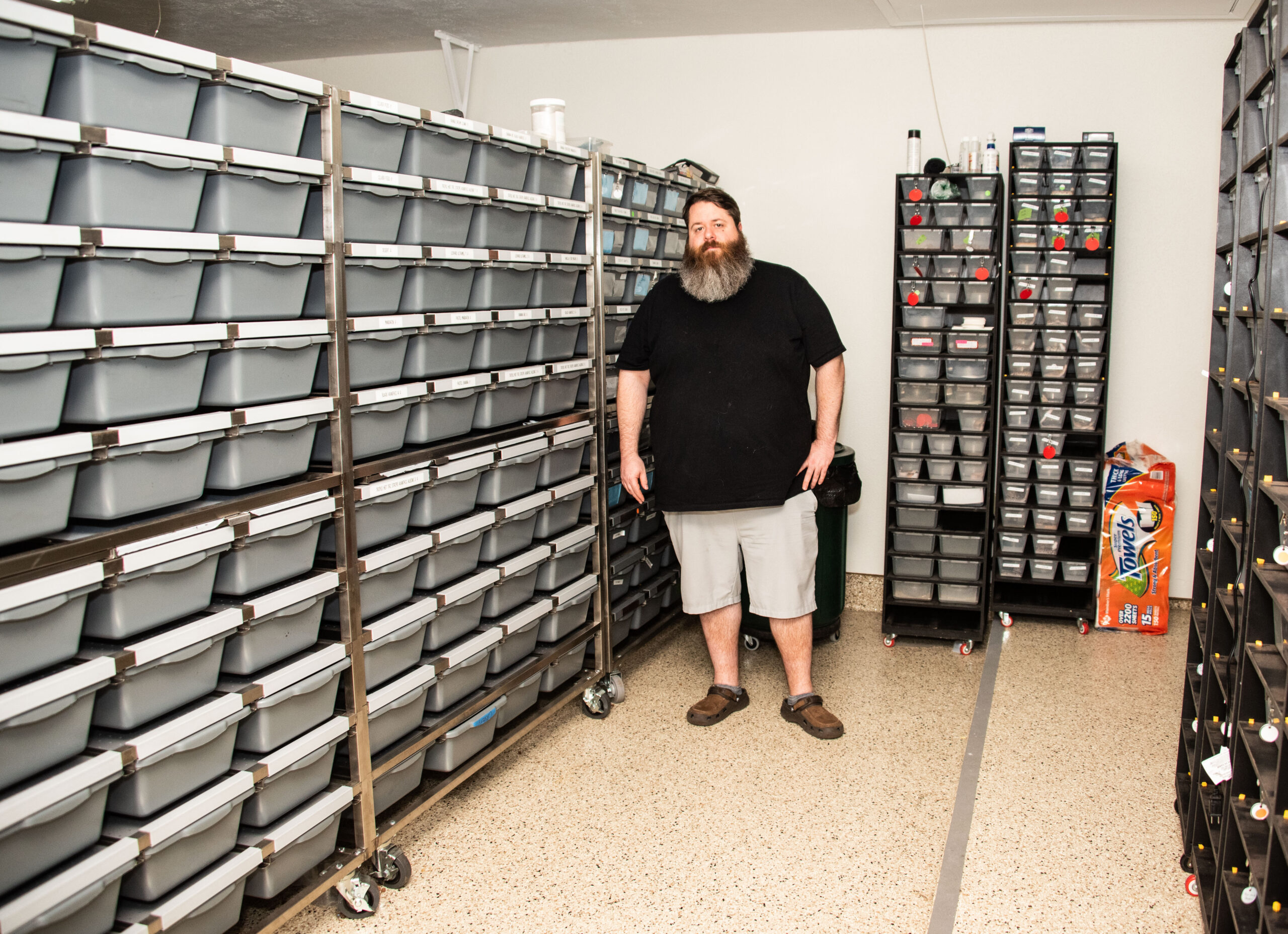
“Are they poisonous?”
“Do they roam freely throughout your house?”
According to Kody Bryan, these are the two questions he and other herpetologists are most frequently asked. Let’s meet Kody as he answers these and other questions about the increasingly popular business of raising snakes.
Kody, when did you develop an interest in snakes?
I grew up in Huntsville and have always had an interest in reptiles since catching snakes and lizards in the neighborhood. I kept reptiles while growing up and even volunteered at a local pet store before I was old enough to get paid for working. After college, my interest was renewed in keeping snakes, but I had begun dating Alex, and when the topic came up, her response was, “If you get a snake, you’ll have to get another girlfriend.” The problem became how to get a snake and keep her, too. I managed to convince her to go to a reptile show in 2016, the Herps Show Conroe, where thousands of reptiles, amphibians, and invertebrates were on display. The different morphs, genetics, patterns, and colors of the ball pythons were beyond belief. Alex found it all fascinating, but declined to hold any of the snakes until one vendor insisted. It was a baby reticulated python and incredibly beautiful. Much to my surprise, Alex was smitten! Now I could have Alex and my snake, too!
Having one snake and having a multitude of snakes are two vastly different things! I understand that you now have more than 350 ball pythons you intend to breed. Please share information about breeding and your goals. And answer one of the frequently asked questions, “Do you let the snakes roam freely throughout your house?”
First of all, no, they don’t roam freely about the house. In fact, these snakes prefer to be in a cozy, safe place and enjoy their privacy. These are animals, and so a great deal of care and consideration must go into providing them with safety, proper nutrition, and a quality environment in which they will thrive. They are housed in a rack and tub system for their comfort, their privacy, and so their environment can be easily maintained to their liking. This also allows for an organized management system so each snake can be observed, fed and cared for, and detailed notes kept for each. This also enables me to regulate the temperature of the environment and have control over the breeding selections and processes. One of the most exciting aspects of breeding is the developing of new morph (color and pattern) combinations. There are currently hundreds of ball python morphs with thousands of combinations that have been and are currently being developed.
While at the 2016 show, I purchased three snakes; before the end of the year, I had thirty. By the end of 2017, my stock was at 60-70, and now more than 350. When I started collecting and
breeding snakes, I began to find other breeders were not quick to share information about their personal breeding projects. A single snake could bring in as little as $50 or as much as $150,000, depending on that particular snake’s genetics. Due to the extreme amounts of money and expenses involved in breeding, it’s little wonder experienced breeders were reluctant to give up their secrets. Fast forward to a few short years later, and now there are plenty of people who are more than willing to share anything and everything with potential up-and-coming breeders and hobbyists. Fortunately, I met the right people early on who have been willing to mentor me. The available information about husbandry, genetics, and other topics is so tremendous it is easy to become overwhelmed. However, over the days, weeks, months, and years of breeding, asking questions, and talking to as many people as I could, my knowledge on the subject and methods of breeding grew, and I began to develop my own exclusive program. If you are passionate about something you want to accomplish, you’ll figure it out. Just push through, and stress becomes success.
All things being equal, a typical breeding season begins in the winter months and can continue through early spring. Theoretically, you could lower your room temperature to begin this process in order to have a more defined breeding season, but that could result in the possibility of having all your females laying eggs at the same time, which would result in a ton of babies and a tremendous amount of work! Therefore, most breeders choose to maintain a constant temperature in their room, which provides greater control over the future workload by spreading out potential clutches throughout the season. You start things off by placing a male and female together, but whether they mate is up to them. Afterwards, the male is returned to his habitat. The female, if gravid (pregnant), will swell as if she ate a big meal or sometimes look as though she swallowed a small football. The process from ovulation to laying is around 30 days. A ball python will usually lay an average clutch of 6-7 eggs, with the possibility of some eggs being infertile. The eggs are leathery, and veining can be seen in the viable ones. Once eggs are laid, I move them to an incubator where they remain until hatched, around 55-65 days. After laying eggs, a female will not eat until her eggs have hatched. By moving them to an incubator, I can get her back into an eating pattern quickly to ensure her health and well-being.
The reptile market is growing exponentially and is fantastically popular around the world. It is a multi-million-dollar global business. The US market for ball pythons is vastly larger than in any other country, with hundreds of millions of dollars spent annually. Most ball pythons will range in price between $50 to $150,000. Any reptile you can legally obtain is potentially sold at reptile shows. A reptile show is kind of like a cross between a trade show and a petting zoo, and vendors are from every walk of life. It’s not uncommon to have a vendor in a business suit carrying on an effortless conversation with another vendor who is tattooed from head to toe.
Some people are in it for the genetic aspects of developing new morphs, and some just think it is a cool hobby. It is not a “get rich quick” business. If you are in it for the money, it takes way too much time, painstaking work, and expense to raise healthy and quality animals. I entered the hobby because I enjoyed the genetic capabilities of the ball python; not just to make money, but to create new and exciting morphs. Alex has supported me in this hobby, or I wouldn’t be doing it. She and I both encourage people to attend a reptile show. Get ready to be in awe!
Yes, they make great pets, but not like a dog or cat. You have a dog or cat for companionship. You have a ball python because they are fascinating to watch and beautiful to look at. A pet snake is more of a visual thing, a display piece, not a cute and cuddly pet. Ball pythons prefer to be left alone, and if you provide a good environment, it’s a good animal to have. The factors that are important in raising a ball python are humidity, temperature, security, food, water, and appropriate hide spots. The snake needs to feel comfortable and secure.
That is a very typical question that people ask. What the person usually means by asking that question is, “If it bites me will I die?” I’ll answer by giving the common answer a breeder gives:
Poisonous means: If you eat it, it could kill you.
Venomous means: If it bites you, it could kill you.
The good news is that ball pythons are neither poisonous nor venomous. Enjoy your beautiful and exotic pet

Postcards Magazine
936-293-1188
PO Box 690
Huntsville, TX 77342
